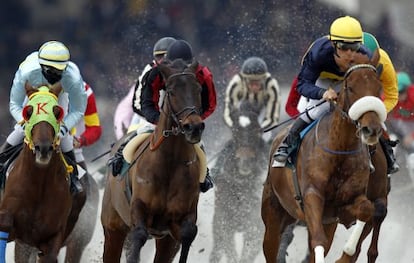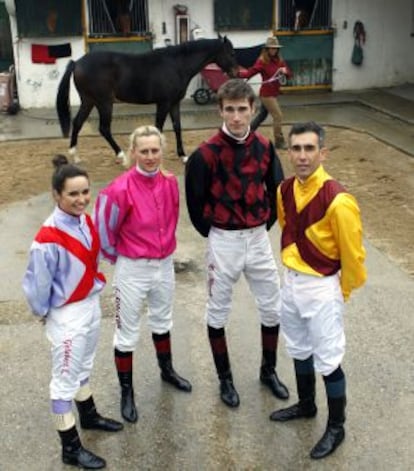Steeplechase racing rides into Madrid
The Hipódromo de la Zarzuela has revamped its activities to attract a new crowd

Román Martín Arranz, 22, is an amateur jockey. But due to his physique - 60 kilograms inside a 1.83m frame - he fears he will never ride professionally, as his grandfather and namesake Román Martín once did. He was one of Spain's legendary riders.
Román, whose father, mother and aunt were also jockeys, was racing on Sunday, which was the first day of the new season at the Hipódromo de la Zarzuela. He was competing in a type of race that he had never tried before, and that had not been witnessed at the Madrid racetrack for the last 20 years: a steeplechase.
The 13 jump races spaced over 49 days of racing (nine more than in 2012) are not the only innovation this season: the racetrack is also bringing back evening races, which were last seen here in 1996.
Racetrack operators are also increasing the prize money for race winners to encourage breeders, raise the level of competition and attract more fans. With these and other additions, the Hipódromo de la Zarzuela is trying to become one of Madrid's premier entertainment centers after a slow recovery from near-death in the mid-1990s. It was shut down between 1996 and 2005 and survived a speculation attempt that would have turned it into land for new construction.
In fact, not content with upgrading its racing activities, the racetrack will take advantage of its prime location right outside the capital, with views of the skyline and the Sierra, to host concerts, exhibitions, fashion shows, video game events and other activities from now until December 6. A children's area boasts inflatable castles, workshops and, naturally, pony rides. Dining and wining is also covered with Villa Gourmet, a food hall that hopes to showcase one of Madrid's natural advantages over, say, Ascot when it comes to watching the thoroughbreds run: enjoying a plate of top-notch jamón with some champagne.
"This is the year of our launch," says racetrack president Faina Zurita Ussía. When Zurita joined the team a year ago, she had a clear goal: turning a profit.

"This is about running a company, but it actually resembles a soccer team in that you cannot just look at the bottom line," she says.
One of the first things she did was put the paperwork in order. "For the first time since its inauguration in 1941, we now have an operating license."
As for the track's finances, it is still in the red. Annual turnover is 15 million euros, but expenditures are 17 million, despite a cost reduction of 20 percent. Zurita is convinced things will change when new gambling legislation finally allows off-track betting. But the main thing now is to get more people to the premises.
"Before, everything focused on the racing fan, the connoisseur, but now we have to attract new people and offer them a convincing, highly special experience."
Spain's racing scene can hardly be compared with that of Britain, the United States, Japan, Australia, Dubai or France. Racing bets in the latter country were around 10.5 billion euros last year, compared with 10 million euros at La Zarzuela, according to race director Gerardo Torres.
Yet Spanish horses and riders often compete abroad, especially in southern France, where many of them end the season.
"We have made great progress professionally," says José Luis Martínez, a 42-year-old jockey who weighs 52 kilos. With his 700 race wins, Martínez could well be the best jockey in Spain. He also took part in Sunday's opening race day, but before that he flew to Dubai to ride the famous racehorse Plantagenet, placing second.
The track is like a soccer team in that you cannot just look at the bottom line"
The track's 110 hectares of land are located just eight kilometers from Puerta del Sol, and feature a grandstand that enjoys historical landmark status. Among this world of riders, breeders, trainers, stable boys, blacksmiths and vets, was 27-year-old Czech jockey Václav Janácek.
"I'm riding good horses here, and my family is happy," says the current leader of the rider statistics. "If there are no good trainers and good horses, it is hard to be a champion."
Jockeys do not ride exclusively for any single stable, and they get 10 percent of the prize money. "The more races, the more money," says Janácek, who will face some of Spain's top riders this season, including Jorge Horcajada, Óscar Ortiz de Urbina and José Luis Borrego.
Here with Janácek is his wife, 25-year-old Ingrid Janáckova Koplikova, one of the few professional female jockeys at the track, along with Spaniards Nieves García, Gloria Madero and Sandra Bermejo. Ingrid, mother of a three-year-old, complains about the sexism in a sport where women may have "the weight advantage" but "men get the best horses."
Bárbara Valentí, 35, is another of the few women who work at Hipódromo de la Zarzuela, in her case as a trainer. She was an amateur rider for six seasons, but says she was not very good. A few months ago she considered switching to Lasarte racetrack near San Sebastián, which is closer to the French circuit, but after the changes at La Zarzuela she decided to stay. She is currently training 16 thoroughbreds belonging to different owners.
Before working as a trainer for 30 years, Francisco Rodríguez, 52, was a rider, and won the Gran Memorial de Madrid at the age of 16. "The horse was good, but I was very good as well," he laughs. Rodríguez says he envies France, "where every village has its racetrack, even if it is a lowly one."
Gone are the times when even soccer players such as Raúl and Guti ("who was allergic, and stayed in the car," says Rodríguez) owned thoroughbreds at La Zarzuela. These days, trainers need the breeders, but breeders need financial stimulus. Luis Álvarez Cervera, who participated in six Olympic Games as a rider and has a broodmare farm in Aranjuez, says that if there are no good prizes to be won, breeders will not feel encouraged to buy colts and fillies. Besides, nobody ever got rich in this game, he says.
"Breaking even is already a success," says Álvarez Cervera. "A horse is shoed once a month, and that costs between 50 and 70 euros - almost as much as decent footwear would set you back."
Tu suscripción se está usando en otro dispositivo
¿Quieres añadir otro usuario a tu suscripción?
Si continúas leyendo en este dispositivo, no se podrá leer en el otro.
FlechaTu suscripción se está usando en otro dispositivo y solo puedes acceder a EL PAÍS desde un dispositivo a la vez.
Si quieres compartir tu cuenta, cambia tu suscripción a la modalidad Premium, así podrás añadir otro usuario. Cada uno accederá con su propia cuenta de email, lo que os permitirá personalizar vuestra experiencia en EL PAÍS.
¿Tienes una suscripción de empresa? Accede aquí para contratar más cuentas.
En el caso de no saber quién está usando tu cuenta, te recomendamos cambiar tu contraseña aquí.
Si decides continuar compartiendo tu cuenta, este mensaje se mostrará en tu dispositivo y en el de la otra persona que está usando tu cuenta de forma indefinida, afectando a tu experiencia de lectura. Puedes consultar aquí los términos y condiciones de la suscripción digital.
Últimas noticias
The complicated life of Francesca Albanese: A rising figure in Italy but barred from every bank by Trump’s sanctions
From digital curfews to blocking apps: How technology experts protect their children online
Why the price of coffee has skyrocketed: from Brazilian plantations to specialty coffee houses
Confined to a Cuban hospital: When electricity is a matter of life or death
Most viewed
- Pablo Escobar’s hippos: A serious environmental problem, 40 years on
- Why we lost the habit of sleeping in two segments and how that changed our sense of time
- Trump’s obsession with putting his name on everything is unprecedented in the United States
- Charles Dubouloz, mountaineering star, retires at 36 with a farewell tour inspired by Walter Bonatti
- The Florida Keys tourist paradise is besieged by immigration agents: ‘We’ve never seen anything like this’








































